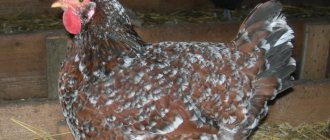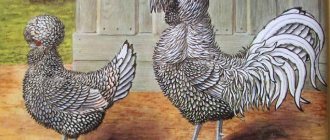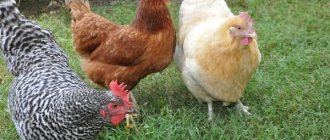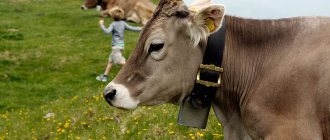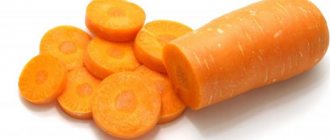History of the breed
Rhode Island - chickens bred in the USA. Farmers worked on breeding work in the mid-20th century. Chicken breeding was first started in the state of Rhode Island, from which the birds got their name.
Today, almost all farmers in this area raise poultry. Chickens have become one of the symbols of the state. Birds took part in the exhibition for the first time in 1880. This indicates that the breed is old. But so far she has not shown any signs of degeneration. Farmers carefully monitored the cleanliness of the line.
When developing the breed, the birds were initially crossed with fawn fighting roosters. Further, the new breed continued to be improved by crossing it with speckled Leghorns, characterized by increased egg production. In Russia, breeding Rhode Island dogs became popular in the 20s of the last century.
Puberty and egg production
Early maturing chickens are highly valued by farmers, and especially by those involved in the poultry business. They want to get the results of their labors and investments as soon as possible. But early laying hens may not always show good results over a long period.
The hen in question cannot boast of a rapid pace of development, and begins laying only in the seventh month of life. But this does not yet indicate that the development process is over. The Rhode Island breed of chickens grows and develops for up to one and a half years.
As for the egg production rates, they are very high, as for a representative of the universal type.
One quonka can produce about 180 eggs per year, weighing about 60 grams. The color of the shells is brown. This is an average, you can get more eggs - it depends on the conditions of detention, feeding and genetic potential.
External and quality characteristics
The Rhode Island has a dark brown color and a bright reddish shaft along the entire length of the feather. The undergrowth is light brown in color. The plumage on the tail is black with a greenish tint. The head is small and has a leaf-shaped, red comb, usually with 5 regular teeth. The lobes are bright red. It has a curved beak, yellowish in color, but with a brown spot. Become powerful - the consequences of crossing with fighting birds.
Birds are characterized by a rectangular, long and deep body. They have a powerful chest and a long and wide back. The neck is short and has a fluffy mane. The small wings have wide feathers. The legs are low, unfeathered, powerful, the metatarsus and toes are yellow. Sometimes there is a red stripe on the sides of the metatarsus. The advantage of Rhode Island cats is mobility and good health when free-range. Animals are undemanding when it comes to food and living conditions.
Representatives of this breed have a balanced, non-aggressive character, but rarely fight among themselves. From them there is no fuss in the poultry house, no conflicts are heard. They are prone to quickly getting used to the owner and can allow him to access their eggs. Such behavioral features are characteristic not only of laying hens, but also of roosters, which are distinguished by their aggressive disposition in other breeds. Rhode Island breeds tolerate changes in feed and temperature well, do not lose weight and are always pleased with good productivity.
White
Rhode Island White was developed in 1888. Sometimes white and red individuals of this breed are crossed to produce highly productive hybrids. A distinctive feature is the color of the plumage. This is a meat-egg variety with similar weight and productivity. The white Rhode Island has a larger comb and a deep red hue.
The white bird was bred by crossing white Leghorn, Conchinchines, and white Wyandots. The first Rhode Island white was registered with the American Poultry Association in 1922. For 40 years the bird was more or less popular, then began to disappear. In 2003, only 3 thousand individuals of this population were registered.
Dwarf
The Rhode Island dwarf was bred by breeders from Germany. The weight of the bird does not exceed 1.2 kilograms, and the mass of eggs does not exceed 40 grams. Representatives of the dwarf variety have the same proportions and species standards as large birds.
The only differences are productivity and egg quality. Dwarf Rhode Island has significantly lower parameters. For these reasons, such birds are bred mainly by collectors.
Description of the Rhode Island chicken breed
Also check out these articles
- Pepper Swallow
- How to plant raspberries in spring
- Amur grape variety
- Flower pots
Rhode Island chickens have a rectangular body. The weight of an adult rooster can reach up to 4 kg, and chickens - 3 kg, however, most often males weigh about 2.5 kg, and females are 500 g less. The back is flat, the chest is convex, the stomach is voluminous. The wings are small, pressed to the body. The legs are long and yellow. The tail of roosters is short, but bushy, located at an angle. The braids are short. The tail of the chickens is small and stands almost vertically.
The neck is of medium length, the eyes are red-brown, the face, earlobes and earrings are red.
Important!
Rhode Island chickens do not like crowded spaces. They need a large chicken coop and an aviary for walking.
The neck is of medium length. The head is small, the crest is single, red, but sometimes there are individuals with a pink crest. The eyes are red-brown. The beak is yellow-brown, medium in length. The face, earlobes and earrings are red.
Rhode Island chickens owe their beautiful, dense plumage to their Malayan ancestor. The feather is red-brown, dark. There are also individuals with a lighter color, and even beige individuals.
Performance
Birds have a fairly massive body structure - this helps produce a large amount of juicy, tender meat. The average weight of males at the age of one and a half years is 3.1-3.9 kilograms. At the same age, laying hens weigh from 2.5 to 2.9 kilos. They are much smaller in size.
Puberty occurs at 7 months. They lay regularly. The Rhode Island breed is an excellent solution when a large amount of production is required. Experts note that the birds have good egg production - a laying hen produces about 160-170 eggs per year. But some individuals are pleased with the record number of eggs laid - up to 215 eggs per year. The average weight of eggs is from 58 to 63 grams. Laying hens produce eggs with light brown, sometimes brown shells.
Contents and diet
Rhode Island is a bird adapted to search for pasture. When free range is limited, the vegetation is quickly destroyed. In this case, it is necessary to provide the animal with a balanced diet. Depending on the age of the bird, housing conditions and diet vary significantly.
Chickens
Rhode Island chicks are born strong and tenacious. This is due to the genetics of previous generations of fighters who were previously used in breeding the breed.
A characteristic feature of this variety is its rapid growth rate. But the growth of feathers is not so rapid - in cubs this process is protracted.
There are no secrets regarding raising young animals. When caring for chickens, farmers adhere to certain rules that are relevant for all varieties. Below are recommendations for raising, feeding and increasing the immunity of chicks:
- By maintaining optimal air temperature, it will be possible to provide the chicks with comfortable living conditions. Initially, the young are kept warm at a temperature of +28-32 degrees, then every 7 days the indicator is gradually reduced by 2 degrees - this contributes to the rapid adaptation of the chicks and adaptation to a normal climate.
- Small chicks are given millet with ground boiled eggs and finely chopped herbs. This food is suitable for young animals over 10 days old. In the future, the diet needs to be expanded by introducing new products to the menu. Birds are usually fed wet and dry mash, vegetables, and cereals.
- They don’t forget about drinking, pouring water into special drinking bowls so that the birds don’t knock them over. Be sure to monitor this, because wet litter can lead to hypothermia and the development of diseases. The chicks are given warm water, no more than 38-40 degrees.
- The breeder will have to take care of the health of the young from the first days of its birth. For this, regular cleaning of the poultry house, disinfection of drinkers and feeders, and the introduction of vitamin supplements into the diet are considered important. Chicks are vaccinated on time against dangerous infectious diseases. Vaccination is not a guarantee that birds will not get sick, but it significantly reduces the risk of developing infections.
- At one and a half months, active chicks are moved to adult relatives. Here they feed from one feeder. They will eat whatever is given to them, because both small and adult individuals especially need protein food.
Adult birds
When selecting feed and formulating a diet, it is important to take into account the basic needs and characteristics of Rhode Islanders. It is believed that birds of this breed are unpretentious in their diet, but this does not mean that they are fed everything. Due to lack of nutrients, productivity may decrease.
It is advisable to feed laying hens whole and crushed grains. Whole grains are poured into feeders as a separate dish, and crushed grains are added to porridges and mashes. The diet must contain grains - birds are fed barley, wheat, rye, corn, and oats. Experienced farmers recommend adding meal and cake. Specialized stores sell ready-made combined feeds containing all the necessary components in the required proportions. You can read more about feeding laying hens here.
In summer, half of the daily diet can be green food. In winter, Rhode Islanders are fed dry grass. During the period of active masonry, it is recommended to increase chalk and shells - this helps to replenish the need for minerals.
Bird keeping
Since this species of birds easily adapts to different conditions, keeping them will not cause any particular difficulties for the owner. In this case, it is necessary to know and take into account some nuances that will allow you to avoid mistakes during breeding. First of all, they are bred both in cages and in standard poultry houses. Considered to be shy, roosters can be aggressive. It happens that birds peck each other, but they are very loyal to humans if they are properly accustomed to their owner. To reduce aggressive behavior to a minimum, you need to monitor the following points:
- whether there are too many birds in one area;
- Are chickens given protein-type food in the required dosage?
- Is it clean where the birds are kept?
- Is there too much lighting?
In industrial production, the beak is most often trimmed; in household conditions, the following measures should be taken to avoid birds pecking each other:
- feed mixtures containing protein - no less than the daily ration;
- turning off the lighting at night, using lamps with a dim type of light, frosted lamps;
- do not exceed the norms for the quantitative maintenance of birds: no more than 15 females per rooster;
- organization of leisure and proper nutrition, including large cut vegetables, fish heads in their entirety;
- periodically provide free range;
- Do not keep them in a common poultry yard with other birds.
Chickens require more careful treatment, given the fact that during the selection process the brooding instinct in Leghorns was completely lost. This feature is necessary to ensure that egg laying does not stop while the hen is incubating the eggs. Therefore, during the breeding process, individuals who had a desire to tinker with offspring were rejected. To get chicks, eggs can be placed in nests with other chickens that have maternal instinct, or you can use an incubator. Eggs are selected without external shell defects, smooth, without cracks or chips. It takes almost a month for the hatching process. Since the percentage of hatching and hatching is very high, this process is quite simple. After the chick appears, at first it needs a high temperature - at least +30 C. The temperature is reduced gradually, bringing it to +19 by the monthly mark.
Features of feeding chicks:
- the first five days the chickens are fed with chopped eggs and semolina;
- on the sixth day you can add chopped greens, boiled vegetables, crushed grains, cottage cheese;
- after the chicks are 14 days old, they are fed with feed mixtures, which additionally include a vitamin-mineral complex and fish oil.
Adult birds feed mainly on grain mixtures of millet and barley in the mornings and evenings. During the day, they are given a mash of boiled potatoes, carrots, nettles and fruits with vitamins, salt and feed-type chalk. We must not forget about chalk, shell rock, and greens, since egg breeds need calcium. Leghorn egg production is at the highest level. We can say that this breed breaks all existing records for the number of eggs per year from one hen. These figures vary around three hundred pieces, while the weight of the eggs ranges from 55 to 70 grams. It is worth noting that from the second year of life the indicators begin to decline. The meat sector is not considered economically profitable, since the body weight of the bird is small - no more than 2.6 kg - and more often than not, even less. In addition, experts consider the taste of the meat to be rather mediocre.
Breeding
Among the bird breeds of combined productivity, Rhode Island is considered one of the best for home breeding. Chickens do not have the brooding instinct, but in 50% of individuals it manifests itself. To increase the offspring of birds, incubators or other brood hens are used.
Hatchability and fertilization rate is up to 75%. Chickens have excellent survival rate, safety is at the level of 95%. Already at one day of age, chickens exhibit sexual dimorphism, thanks to the golden gene. There is a characteristic spot on the top of the head, which allows the farmer to form a flock of potential laying hens. Roosters do not have such a mark - they are reared separately. In this way, it is possible to fatten the brood specifically for meat in a short period of time.
Breeding the breed for commercial purposes is not advisable, which is why purebred individuals are extremely rare. But Rhode Island roosters are used to raise broilers. They contribute to a significant improvement in meat characteristics, for example, in Kuchinsky Jubilee.
Diseases and methods of prevention
Rhode Island birds begin to get sick due to inappropriate care or poor, unbalanced nutrition. The farmer needs to pay attention to the appearance of the birds: if they look disheveled, indifferent to food, sleep standing away from everyone, their eyes are dull and their plumage is “dirty”, this indicates an animal illness. They must be isolated immediately to avoid infecting other birds.
The most common chicken diseases:
- lice;
- atony;
- mites;
- cannibalism;
- lice eaters;
- inflammation of the cloaca;
- smallpox;
- intestinal disease (diarrhea);
- paralysis;
- coccidiosis;
- cholera;
- Pullorosis-typhoid fever.
The main prevention of diseases in Rhode Island chickens is proper varied nutrition with high-quality feed, space in the poultry house, regular cleaning of cages, disinfection of the room, compliance with temperature and air humidity.
How do breeders respond to chickens?
Currently, many people keep various breeds of chickens on their farms, because their maintenance does not require very much cost. Keeping chickens on private farms is not difficult, and having fresh eggs and dietary meat on the table in various situations is very convenient
Rhode Island chickens get special attention
In this article you will find all the latest information: characteristics, features of Rhode Island chickens, as well as their descriptions and photographs.
This Rhode Island breed dates back to 1840-1852 in the USA. And in 1926, Rhode Island chickens came to Russia for the first time.
This breed is very common and very popular. Chickens have excellent meat and egg production qualities.
Photo of Rhode Island chickens.
External description of Rhode Island chickens:
- The chickens themselves have rich, red-brick plumage, dense in structure. But as the years pass, the color fades slightly.
- The head of such chickens is medium, rounded, with a five-toothed comb.
- The neck is strong and of normal length.
- The shape of the beak is bent, it is colored yellow. The beak may be short, but it can also be normal.
- Rhode Island chickens have strong legs and no feathers.
- The wings are small, covered with wide feathers.
- The body is quite bulky, heavy, and has a voluminous sternum.
- The tail feathers are slightly rounded and not long.
- The color is mainly black, but diluted with various tints.
- The eyes and ears are colored red.
- The midfoot is without feathering, edged on the sides in red.
Photo of a Rhode Island chicken.
The average weight of a Rhode Island chicken is 3 kg, a rooster is 4 kg. A laying hen produces up to 200 eggs per year, each weighing 60 grams. The shell color is predominantly brown. A pullet hen begins laying eggs at 7 months.
Video: description of Rhode Island chickens.
There are exceptions and hens want to become mothers, an average of 14 eggs need to be laid under them. Chicks from the brood survive 95%.
But still, according to the description of experienced poultry farmers and farmers, breeding Rhode Island laying hens is unrealistic. To produce offspring, you should use another whooping whale or an incubator.
Photo of a Rhode Island hen and chicks.
By the way, birds of this breed represent the primary material for crossing and breeding new breeds.
An important characteristic of Rhode Island chickens is their undemanding behavior, patience, and amazing vitality. Egg laying is done throughout the year, they feed on anything and a well-composed diet.
There are also smaller brothers (in the literal sense of the word). The dwarf subspecies is the Rhode Island mini-chicken. They lay 120 eggs per year weighing 40 grams, “ladies” weigh 1 kg, roosters weigh 1 kg 200 grams. This breed has taken root in private households and small farms, and Rhode Island mini-chickens are not welcome in the wider poultry industry.
Photo: large Rhode Island rooster.
Advantages and disadvantages
The bird breed has many positive qualities. Initially, they note the animals’ unpretentiousness to living conditions and the ability to raise them in different climatic conditions. The universal nature of the breed is also considered a plus - a farmer can use it to produce both meat and eggs. Carcass meat has high taste qualities. Puberty begins early; proper maintenance allows for 100% survival rate of chickens.
Disadvantages include average egg production and a high rate of rejection of animals based on breeding characteristics. Because of this, the breed is not practical to raise commercially. It is bought by breeders who breed birds on small farms to breed new crosses.
Reviews
There are many positive reviews about the Rhode Island breed on the Internet. Here are some of them:
★★★★★
Peter, 41 years old, farmer. I have been raising Rhode Island chickens for almost 10 years.
He started with a small farm, over time it turned into a farm with 400 individuals. I have tried raising other breeds, but for me the main priority is the taste of the meat, and the rest remains in the background. My family and I have not bought meat in stores for many years; we prefer our own fresh, homemade meat. Even if you have never had to deal with birds, Rhode Islands are animals with which there are no difficulties. ★★★★★
Ksenia, 35 years old, housewife. I once acquired Rhode Islanders to get meat and eggs.
I can confidently say that for those who live in private homes, this breed is the best. I was told that laying hens produce large eggs, but in reality it turned out that their size is quite normal - 50-60 grams. It was very important to me that the birds were not aggressive, because there are five small children in the family. The seller assured that the animals were very calm - this turned out to be absolutely true. Even roosters do not show aggression, so you can safely go out into the yard without being afraid of these birds. We are pleased not only that birds give eggs, but also that they have tender, juicy meat.
★★★★★
Sergey, 44 years old, breeder. I once tried to breed a breed of Faverol birds, and regretted it; they turned out to be overly gentle, with a low level of resistance to disease and weather conditions, and because of this they quickly died.
Then a friend recommended that I buy Rhode Islanders. I looked at their photos, found a lot of information on the Internet, from which I concluded that this is an industrial cross, and I certainly won’t see any chickens. But a friend explained that in fact this breed is often involved in breeding meat and egg crosses, that is, it is quite possible to get purebred chicks from Rhode Island birds. I believed her beliefs, and how good it was. The birds have good egg production and the chicks hatch well. Chickens are versatile and can be kept in cages. I'm happy with everything.
Hide
Add your review
Rhode Island are unpretentious birds, they have many positive characteristics. With proper care, regular cleaning of the poultry house and taking preventive measures, the animals will not get sick, will quickly gain weight, and will delight their owners with juicy meat and medium-sized eggs.
0
0
Copy link
Content Features
Nowadays, Rhode Island chickens are kept mainly in the private farms of individual breeder enthusiasts. At the same time, the main livestock is of the industrial type, when the selection was made precisely for productivity, and the appearance according to the standards was compromised. Most often this manifests itself in a lighter coloration of the bird. Therefore, in private farms, work is underway to restore the standard qualities of the genera, including the exterior.
Farmers note that the breed is resilient and unpretentious, suitable for breeding in Russian conditions. It is no coincidence that Rhode Islanders are one of the most popular meat and egg breeds in European countries.
Productivity Features
In terms of productivity, the excellent taste of the meat, the pleasant appearance of the carcass due to the yellowish skin and the absence of stumps are noted. The weight of a gutted carcass can reach up to 2.8 kg. Eggs are also delicious, especially from free-range birds.
The industrial type of the breed is characterized by increased egg production and earlier maturation. Chickens begin to lay eggs as early as five months. They lay eggs regularly until late autumn. After moulting, they can lay eggs all winter long with good feeding and additional lighting. Maximum egg production is achieved at the age of about one and a half years, after which productivity gradually decreases.
If you select for appearance, the meat qualities are enhanced, maturation slows down, and the number of eggs decreases.
When using bunker feeders and automated operation of drinking bowls, you can safely keep grown-up Rhode Island cats at the dacha, visiting them 1-2 times a week. But at the same time, you need to take care of protection from various predators, including stray dogs.
Chickens
Day-old chicks can be colored brown in a variety of shades from light to dark chestnut. The black stripes or spots seen on some chicks disappear as they grow. By coloring it is usually possible to determine the sex already in the first day: hens most often have a spot on the back of the head. The second sign is the color of the down on the wings of the chicks. In cockerels it is light, almost white, in chicks it is brown, sometimes it may have lighter stripes.
We have problems purchasing purebred chickens and hatching eggs. According to professionals, breed violations also affect the quality of the egg: fertility and hatchability of chickens decrease. At the same time, feeding and transportation conditions greatly influence incubation properties. Confidence in poultry farms supplying eggs of different breeds is decreasing due to the appearance of chickens of other breeds in the brood.
Fertilization of 65% is already considered good. To increase it, it is recommended that owners add vitamin supplements to the feed at the time of collecting eggs for incubation, using fish and fish oil, corn, and vitamin E.
If these conditions are met, private farms achieve 100% fertility and 100% survival rate. Amicable hatching of chicks is noted. Day-old chicks are mainly given boiled eggs, Solnyshko feed, cottage cheese, and boiled fish. Such a diet, according to farmers, promotes the rapid growth and development of chickens and their resistance to adverse factors. They also enjoy eating fresh greens, especially dandelions, scalded and chopped nettles. Cockerels mature faster, so they are separated at another 2-3 months for fattening.
Feeding
For adult birds, a good food is a mixture of crushed grains of wheat, barley, corn, and oats. For fattening, you can also add sunflower seeds, but experience shows that in this case egg production decreases.
With good care, Rhode Island dogs delight the eye with their beautiful appearance, calm and sociable disposition. And the owners will be provided with delicious eggs and dietary meat.
